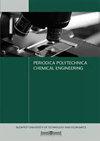新型改性固化剂在胶合板工艺中的应用:对脲醛树脂固化及甲醛释放量的影响
IF 1.8
4区 工程技术
Q3 ENGINEERING, CHEMICAL
引用次数: 0
摘要
在胶合板和木板技术中,迫切的科技目标之一是寻找减少热压时间而不增加成品甲醛释放量的方法。为解决这一问题,研制了一种新型改性剂——固化剂MC-4SF,主要是柠檬酸与尿素和氨相互作用的产物。与传统的铵盐相比,该改性固化剂具有直接催化剂和潜在催化剂的双重性能。对100℃固化树脂水提物中残留甲基的组成测定表明,改性固化剂在萃取过程中对uv -聚合物具有较高的水解稳定性。固体13C核磁共振光谱表明,与标准催化剂固化的树脂相比,MC-4SF固化的树脂中亚甲基桥的化合物增加。在改性固化剂中包含的尿素(或其衍生物)的氨基可能与UF低聚物的甲基反应,使尿素融入所得聚合物的结构中。这就解释了固化树脂的水解稳定性提高和毒性降低的原因。用改性固化剂制成的九层胶合板的制造试验表明,用MC-4SF代替硫酸铵可以显著减少110°C下的压制时间,而不会损失成品的质量。在相同的压制时间下,可以将线抗剪强度提高14%,甲醛排放量降低45%。本文章由计算机程序翻译,如有差异,请以英文原文为准。
Usage of the New Modifier-curing Agent in Plywood Technology: The Influence to Urea-formaldehyde Resin Curing and Formaldehyde Emission
One of the urgent scientific and technical objectives in the technologies of plywood and wood boards is the search for ways to reduce of hot pressing time without increasing the formaldehyde emission from finished products. To solve this problem was developed the new modifier-curing agent MC-4SF, is mainly a product of interaction of citric acid with urea and ammonia. Compared to traditional ammonium salts, the modifier-curing agent combines the properties of both direct and latent catalysts. Determination of the composition of residual methylol groups in the aqueous extracts obtained by treating the resin cured at 100 °C showed that the modifier-curing agent provides relatively high hydrolytic stability of the UF-polymer during extraction. Spectra of solid-state 13C NMR showed that in resins cured with MC-4SF increased the compound of methylene bridges compared to resins cured with standard catalysts. It is possible that the amino groups of urea (or its derivatives) included in the modifier-curing agent, react with the methylol groups of UF oligomers, fitting urea into the structure of the resulting polymer. Thus explains the increased hydrolytic stability and reduced toxicity of the cured resin. Manufacturing tests of nine-layer plywood made with a modifier-curing agent showed that replacing ammonium sulfate with MC-4SF allows a significant reduction in pressing time at 110 °C without loss of quality of the finished product. With the same pressing time, it was possible to increase the line shear strength by 14% and to reduce formaldehyde emission by 45%.
求助全文
通过发布文献求助,成功后即可免费获取论文全文。
去求助
来源期刊

Periodica Polytechnica Chemical Engineering
ENGINEERING, CHEMICAL-
CiteScore
3.10
自引率
7.70%
发文量
44
审稿时长
>12 weeks
期刊介绍:
The main scope of the journal is to publish original research articles in the wide field of chemical engineering including environmental and bioengineering.
 求助内容:
求助内容: 应助结果提醒方式:
应助结果提醒方式:


